40 igneous rock ternary diagram
QAP Streckeisen ternary diagram illustr ating the calculated. for rocks from the Halifax Pluton of the South Mountain Batholith. Data. and symbols plotted on top and bottom as in Figure 21. T ... The AFM diagram is a ternary plot in which the concentrations of Na2O + K2O (alkalis; A), FeO (F) and MgO (M) in an igneous rock are plotted after recalculation to a sum of 100%. If the rocks plotted belong to a magmatic series, they will define a trend (Fig. 5).
Igneous rocks are those that form via the process of melting and cooling. If they erupt from volcanoes onto the surface as lava, they are called extrusive rocks.By contrast, Intrusive rocks are formed from magma that cools underground. If the intrusive rock cooled underground but near the surface, it is called subvolcanic or hypabyssal, and often has visible, but tiny mineral grains.
Igneous rock ternary diagram
How to plot ternary diagrams. Ternary diagrams Used to represent three variables Very useful for geochemical and petrological data Often used as a means of classifying data and rocks Ternary Diagrams Suppose we have a hypothetical rock with the following hypothetical minerals: P 23.2% Q 25.2% X 36% Y 10.4% Z 5.2% Total 100% Now suppose we want ... Once data have been imported, the user can visualize them using three different types of diagrams commonly used in igneous petrology: binary, ternary, and spider diagrams . All diagrams can be easily generated in few steps. For example, a binary or a ternary diagram can be created in only 3 steps as described in Figure 3. Several options are ... Basic igneous rocks, like basalts and gabbros will plot in the field of Basic Rocks, and siliceous limestones and dolomites will plot in the field of Calcareous Rocks. This diagram and the fields shown will become an important part of later discussions, so it is wise to know approximately where the fields of these different chemical types occur ...
Igneous rock ternary diagram. MgrSirO6 (En)- FerSirOu Q-J diagram for the pyroxenes, on which the posi tions of the I 3. The pyroxenes (commonly abbreviated to Px) are a group of important rock- forming inosilicate minerals found in many igneous and metamorphic rocks. ternary diagram can be useful! - Pyroxenes. - Feldspars. - Garnets (*2!) proportions for plotting on the ternary diagram. Note that it is possible that only two of the minerals on the IUGS ternary may be present in the rock and those samples will plot on the side of the ternary containing the two minerals present. Step 3: With the IUGS ternary selected in (2), plot the composition with a ink dot and label on the ... These features make rock classification difficult and undermine its quality, thereby negatively impacting geological conclusions and mineral exploration results. A novel alternative procedure for igneous rock classification involves using whole rock lithogeochemical data for classification on Streckeisen ternary diagrams. Diagram of Miyashiro (1974) distinguishing between tholeiitic and calc-alkaline igneous rocks. SiO2 - K2O (Peccerillo + Taylor 1976) PeceTaylor G SiO 2 vs. K 2 O binary Diagram proposed by Peccerillo & Taylor (1976) to distinguish various series of tholeiitic, calc-alkaline and shoshonitic rocks. Co - Th (Hastie et al. 2007) Hastie G Co vs. Th
The classification of igneous rocks is largely based on two diagrams: QAPF diagram for plutonic rocks (formed in the crust) and TAS diagram for volcanic rocks. I made the schemes using the coordinates provided in the following book: Le Maitre, R. W. (2005).Igneous Rocks: A Classification and Glossary of Terms: Recommendations of the International Union of Geological Sciences Subcommission on ... The QAP ternary diagram is used to classify igneous rocks with visible mineral grains (phaneritic texture) from their feldspar and quartz content. In plutonic rocks , all of the minerals are crystallized into visible grains. 16 May 2017 — Abbreviations: AF, alkali feldspar; PL, plagioclase; QZ, quartz; FD, feldspathoid. Numbers adjacent to the ternary diagram classification field ... This activity takes place in a laboratory setting and requires ~1.5-2 hours to complete. Students observe igneous rock compositions and plot them on triangle diagrams, normalize rock compositions using a spreadsheet, and identify the rocks.
ternary given a bulk rock composition. •Be able to explain the meaning of "crossing" tie lines (i.e. sample is in disequilibrium or it happens to be located on a univariant curve). •Be able to predict mineral reactions or replacement textures based on a bulk composition on 2 different ternary diagrams representing a change in grade. A QAPF diagram is a double ternary diagram which is used to classify igneous rocks based on mineralogic composition. The acronym QAPF stands for "Quartz, Alkali feldspar, Plagioclase, Feldspathoid (Foid)". These are the mineral groups used for classification in QAPF diagram. Q, A, P and F percentages are normalized (recalculated so that their sum is 100%). Ternary Variation Diagrams Example: AFM diagram (alkalis-FeO*-MgO) Figure 8-2. AFM diagram for Crater Lake volcanics, Oregon Cascades. Data compiled by Rick Conrey (personal communication). Models of Magmatic Evolution hypothetical set of related volcanics. Oxide B BA A D RD R SiO2 50.2 54.3 60.1 64.9 66.2 71.5 TiO2 1.1 0.8 0.7 0.6 0.5 0.3 Chapter 03 - Igneous Rock New Clasification (Plotting on Ternary Diagram I) - Free download as Powerpoint Presentation (.ppt), PDF File (.pdf), Text File (.txt) or view presentation slides online. Wolfgang Morche - Curso post-grado UNMSM / FGMMSC - Igneous Rocks
GCDkit is a program for management and recalculation of whole-rock geochemical data for igneous and metamorphic rocks. It is built using the open-source (freeware) R language, version for Windows, which in itself provides a flexible and comprehensive environment for efficient data processing, visualization and statistical analysis ( Ihaka ...
Igneous Phase Diagrams. Bowen worked out his ideas on the evolution of igneous rocks by doing laboratory experiments with artificial magmas. Bowen proposed (1922) that any one magma can potentially crystallize into rocks of different compositions because of two processes. 1.
LAB 6 INTRUSIVE IGNEOUS ROCKS, PART 1 Tonalite, Diorite, Gabbro, Norite, and Anorthosite These intrusive (plutonic) rocks correspond to fields on diagram 2-2 of Winter. They are rich in plagioclase feldspar. More information about these rocks is included in chapters 11, 13, and 14 of Moorhouse. This is the first examination of intrusive rocks ...
ESS 210 Lab 6: Igneous Rock Identification . Ternary classification of felsic to mafic igneous rocks. The top diagram is for extrusive rocks and the lower is for intrusive rocks. Note that rocks with glassy or pyroclastic textures may be described by the above compositions, but that for these specimens the final rock name must still ...
These features make rock classification difficult and undermine its quality, thereby negatively impacting geological conclusions and mineral exploration results. A novel alternative procedure for igneous rock classification involves using whole rock lithogeochemical data for classification on Streckeisen ternary diagrams.
Finding what is the norm of the rock. A norm is an estimation of the ideal mineralogy of an igneous rock, based on the chemical composition of the rock. The most common norm calculation method is the CIPW norm, but there are other methods as well. For starters you should do fine with the norm.
Quiz prep for igneous rocks and ternary diagrams. Question. Answer. A dark colored igneous rock with no visible crystals cooled how? quickly on the earth's surface. Large crystals found in a fine-grained groundmass can indicate what? origin from a magma with an early intrusive phase followed by an extrusive phase and that it is a rock of mixed ...
This can be illustrated in the feldspar compositional ternary diagram. Feldspar minerals are the most abundant constituents of igneous rocks. Despite being sensitive to weathering and alteration, feldspars are abundant (second after quartz) in arenaceous sedimentary rocks, either in form of detrital grains or as secondary, authigenic phases.
Ternary igneous phase diagrams are triangular diagrams that show melting relationships involving three chemical components. The diagrams may involve eutectic, peritectic and cotectic relationships. ... Metamorphic T-X Phase Diagrams. For some rock compositions, metamorphic assemblages vary greatly depending on the composition of the fluid present.
9%) ternary diagrams of basaltic rocks collected on the Mid-Atlantic Ridge near. The pyroxenes (commonly abbreviated to Px) are a group of important rock- forming inosilicate minerals found in many igneous and metamorphic rocks. The compositional range of the Ca-rich, Al- free pyroxenes in shown in the triangular composition diagram here.
A: In general you can plot any sort of boundaries and/or labels you want with a ternary plot (aka triangle plot, depending on what world you work in), and your "but the line disappears" is easily explained. But more on that below. First, yes you can plot mafic and ultramafic rock classifications starting with version 2.2.6.
Geochronology and Correlation of Tertiary Volcanic and Intrusive Rocks in Part of the Southern Toquima Range, Nye County, Nevada By Daniel R. Shawe, Lawrence W. Snee, Frank M. Byers, Jr., and Edward A. du Bray
One popular type of bivariate diagram is a TAS plot. TAS is an acronym for Total Alkali vs. Silica. This type of plot is used to classify igneous rocks by comparing the weigh percentage of SiO2 with the weight percentage of NaO2 plus K20 in a particular rock sample. Specific ranges of this ratio are assigned a specific compositional classification.
Basic igneous rocks, like basalts and gabbros will plot in the field of Basic Rocks, and siliceous limestones and dolomites will plot in the field of Calcareous Rocks. This diagram and the fields shown will become an important part of later discussions, so it is wise to know approximately where the fields of these different chemical types occur ...
Once data have been imported, the user can visualize them using three different types of diagrams commonly used in igneous petrology: binary, ternary, and spider diagrams . All diagrams can be easily generated in few steps. For example, a binary or a ternary diagram can be created in only 3 steps as described in Figure 3. Several options are ...
How to plot ternary diagrams. Ternary diagrams Used to represent three variables Very useful for geochemical and petrological data Often used as a means of classifying data and rocks Ternary Diagrams Suppose we have a hypothetical rock with the following hypothetical minerals: P 23.2% Q 25.2% X 36% Y 10.4% Z 5.2% Total 100% Now suppose we want ...

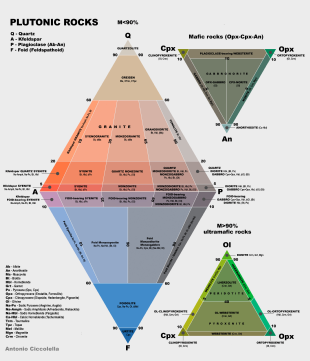

.jpg)





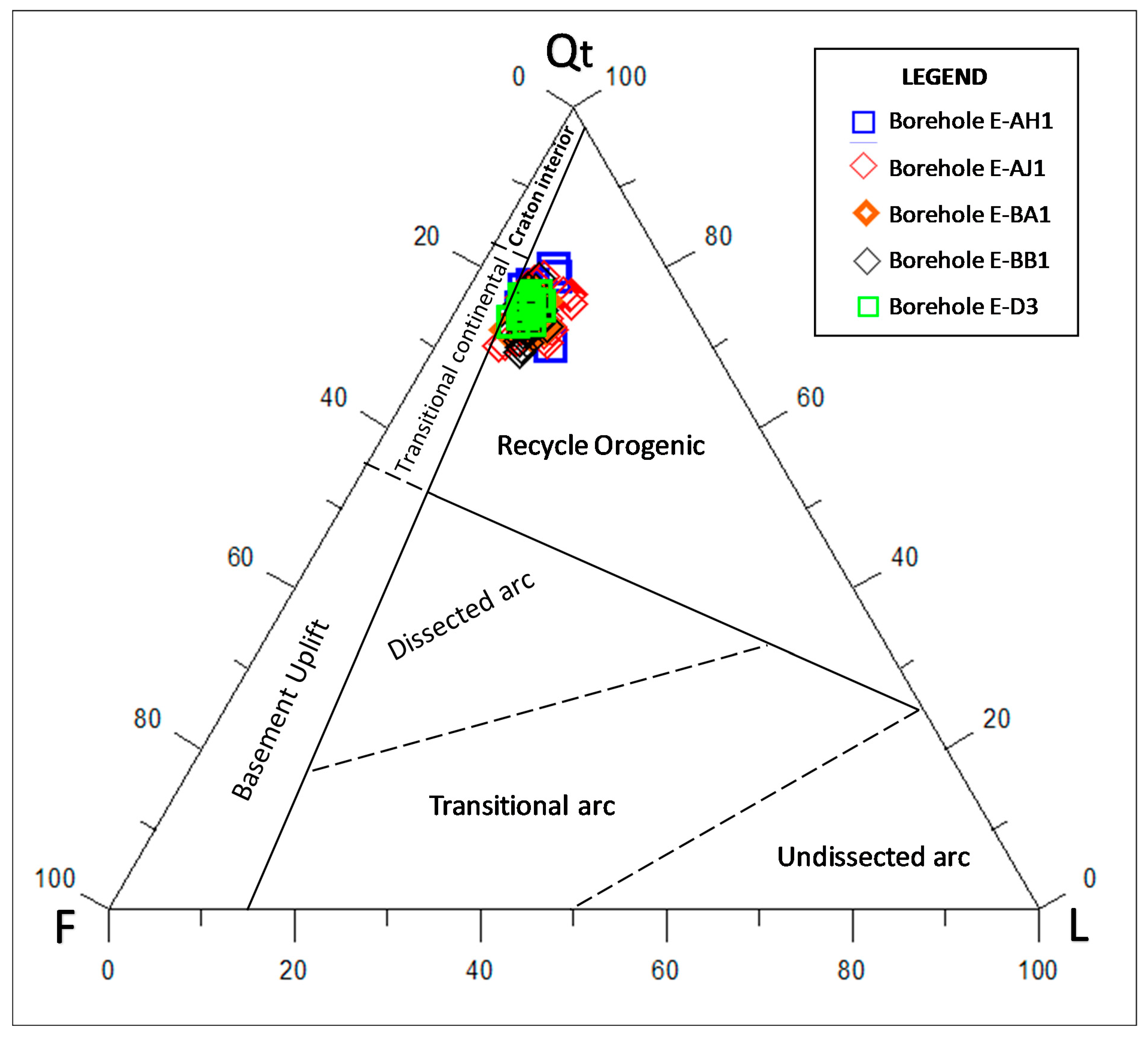



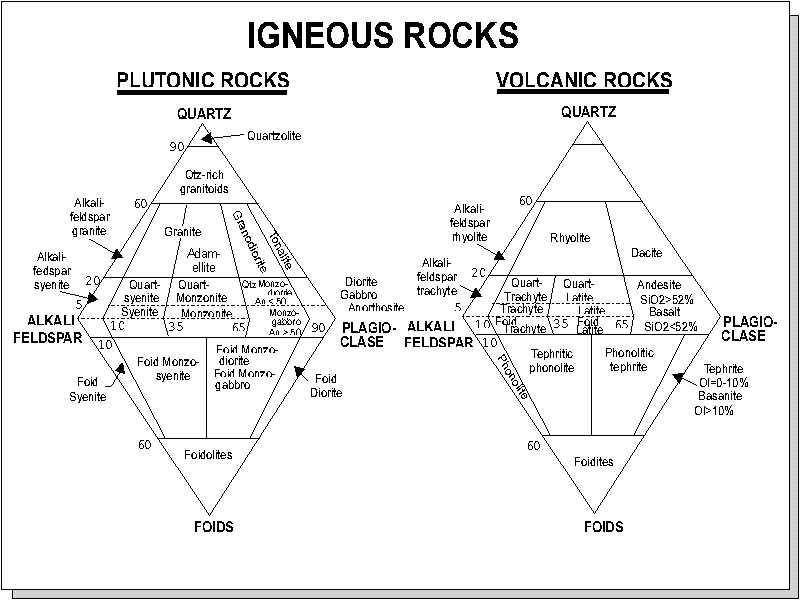



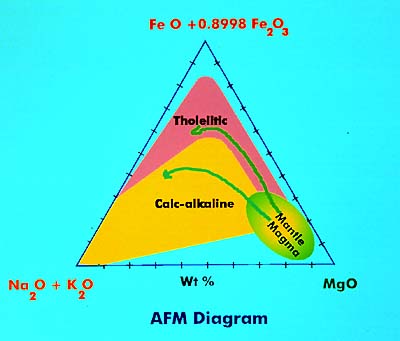


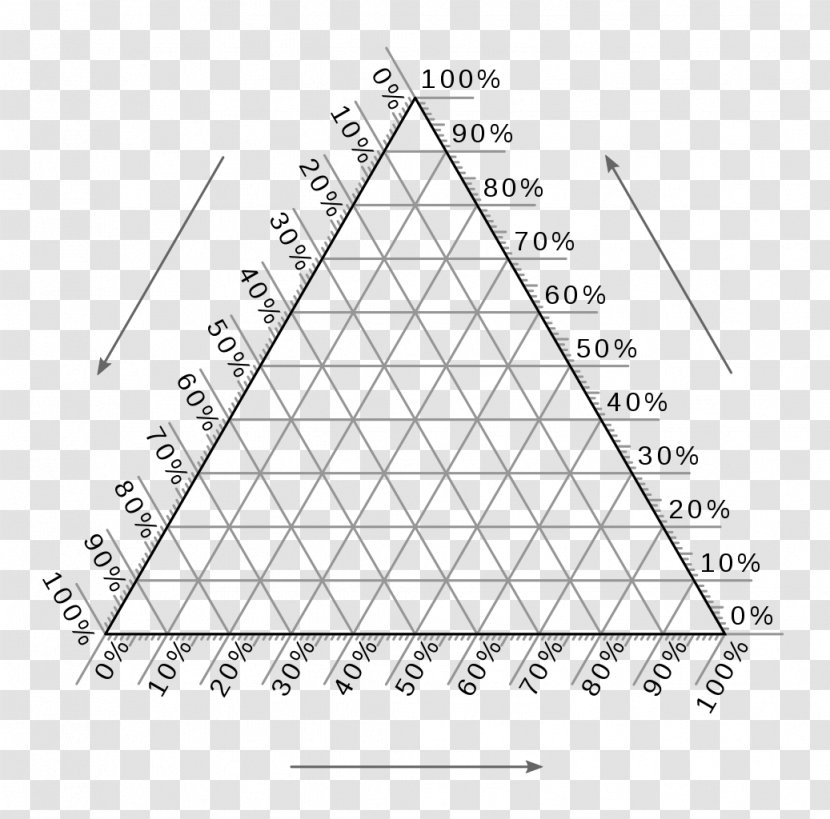


0 Response to "40 igneous rock ternary diagram"
Post a Comment